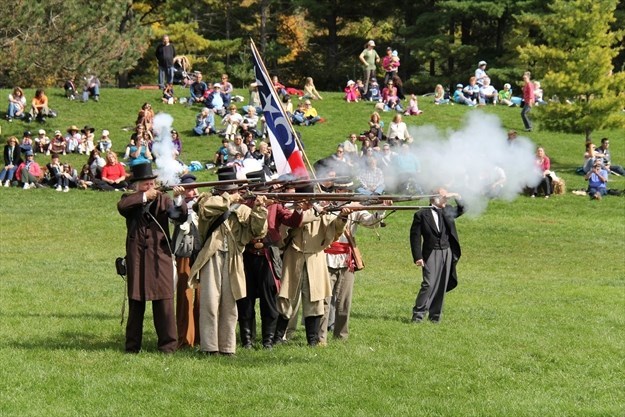During December, we're featuring some of 'the best of' local historian Richard MacLeod's popular Remember This, Newmarket column. This column was originally published Sept. 18, 2018 in advance of the Rebel Heartland event.
***************
I am providing the highlights of a short walking tour that I have led over the years that retraces the locations where Upper Canada’s 1837 Rebellion began, a movement involving many of our local residents on both sides of the issue.
Hewitt's Hotel: At the northwest corner of Main and Botsford streets. Hewitt’s Hotel, later the North American, was built by Joseph Hewitt in 1826 and demolished c. 1900. The site is currently occupied by the Goulash House. It was at a meeting here on Aug. 3, 1837 between disgruntled local residents and William Lyon Mackenzie that rebellion was first openly discussed.
Presbyterian Kirk: The new Kirk (church) stood at the northeast corner of Timothy and Church streets in 1837. It was used as a jail for 46 rebels following Mackenzie’s ill-fated attempt to capture Toronto. The prisoners were chained together and force-marched to Toronto through bitter winter cold. The Kirk was demolished in 1907.
Caldwell House: The home of James B. and Rosanna Caldwell, this house stood on the southeast corner of Botsford and Church streets, on the north side of the former Kirk site. J. B. Caldwell was a chair maker and pointer who had a shop on Main Street. Though a reform sympathizer, he drew the line at armed conflict. He was allowed a parole by the authority, and ran messages between the prisoners in the Kirk and their families. Rosanna smuggled food through her backyard and into the Kirk. Following the Rebellion, the Caldwells built Liberty Hall on Botsford Street (which is still there today).
Cawthra House: John Cawthra was a reform supporter who opposed violence. When talk of armed rebellion began, he tried to warn Lieut.-Gov. Head, who reportedly replied, “They know too well which side their bread is buttered on to attempt rebellion.” This remark led to a scene in a field west of Newmarket where rebels trained by firing at loaves of buttered bread stuck on poles. The Cawthra House is on the northwest corner of Main and Water streets (still there).
The Willows: The home of William and Sarah Roe, The Willows stood on the northeast corner of Main and Water streets, on the present site of a real estate building. William Roe won fame as a teenager during the War of 1812 by hiding “the government treasury” from the invading Americans. He came to Newmarket as a fur trader following the war. Roe was a supporter of the Family Compact and was rewarded for his loyalty after the rebellion by being appointed Newmarket’s second postmaster, a position he held until his death in 1879.
Gorham House: On Gorham Street (named after Nelson’s father Eli), east of Prospect, the Gorham House was Newmarket’s first brick house. Nelson Gorham was a rebel leader who fled with Mackenzie to the United States following the rebellion and became a member of the Provisional Government of the State of Upper Canada that Mackenzie established on Navy Island in the Niagara River. As a captain in the “Patriot” army, Nelson Gorham was responsible for enrolling new recruits. He returned to Newmarket following his pardon in 1843 and in later years became our village reeve.
Beman-Robinson House: Originally located on Water Street at the foot of Main, the Beman-Robinson House now stands on Eagle Street across from Church Street. Newmarket’s first house, it was built c. 1804, possibly as early as 1801, by Joseph Hill. It was later owned by Elisha Beman, who married widow Esther Sayre Robinson and became stepfather to her five children. They were important members of the colonial elite. “Squire” Beman was a prominent businessman, magistrate and justice of the peace, and his three stepsons were: a) Peter Robinson, founder of Holland Landing and Peterborough, businessman, fur trader and high government official; b) Sir John Beverly Robinson, attorney-general, chief justice and lieutenant-governor; c) William Beverly Robinson, fur trader, high government official and Newmarket's first postmaster.
Eagle Street Cemetery: This little cemetery on the north side of Eagle Street is the final resting place to some who supported the government side in the rebellion: William and Sarah Roe; Elisho Beman; Lieut. Arthur Carthew (who led an expedition to relieve Toronto, arriving a week after the rebellion).
See a video from the Rebel Heartland weekend here.
NewmarketToday.ca brings you this weekly feature about our town's history in partnership with Richard MacLeod, the History Hound, a local historian for more than 40 years. He conducts heritage lectures and walking tours of local interest, as well as leads local oral history interviews. You can contact the History Hound at [email protected].
